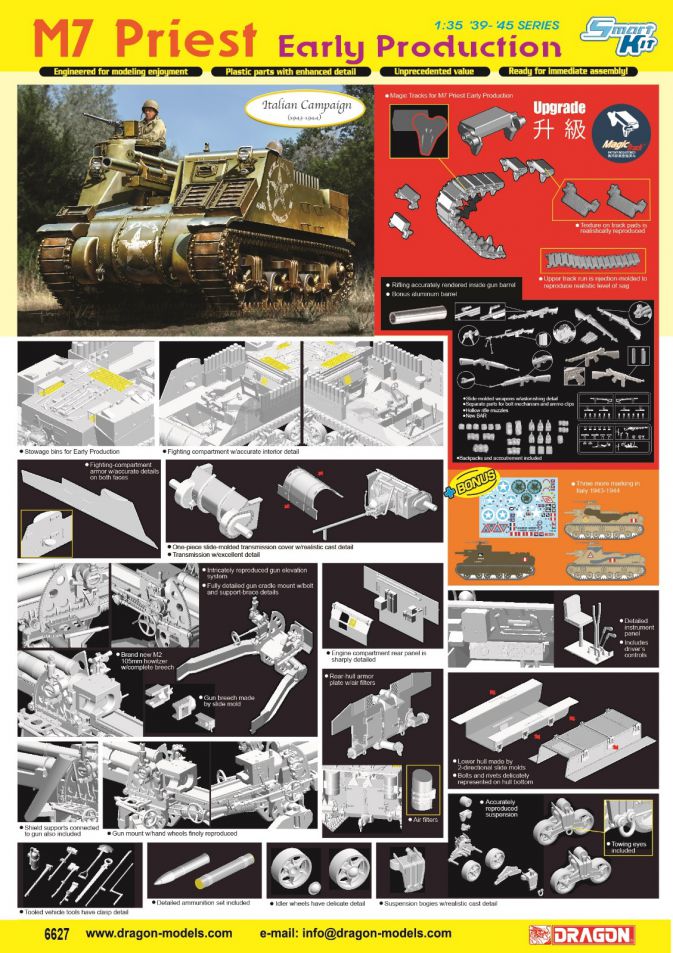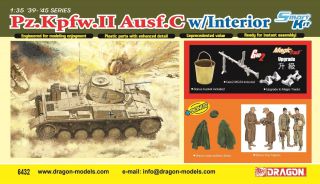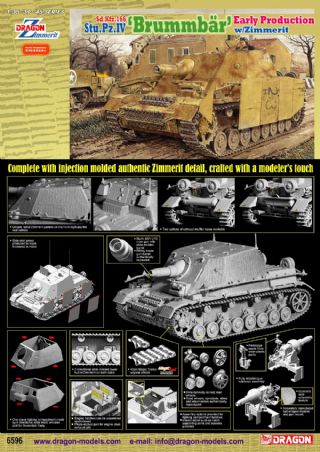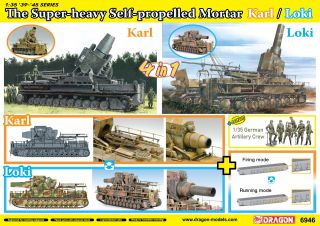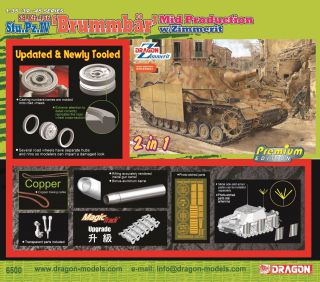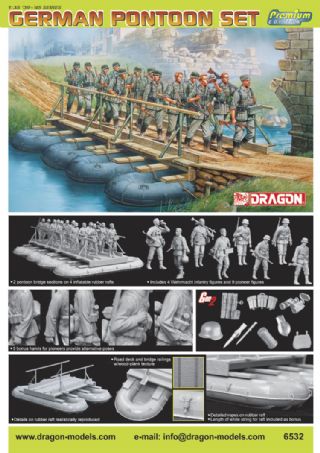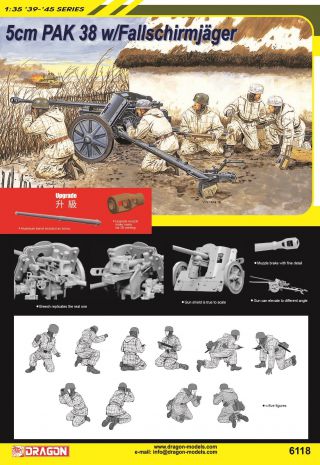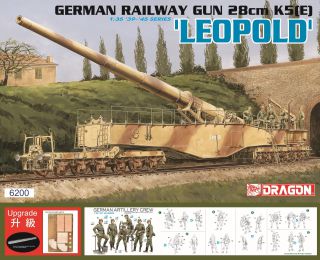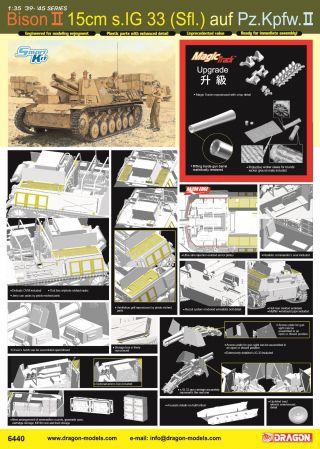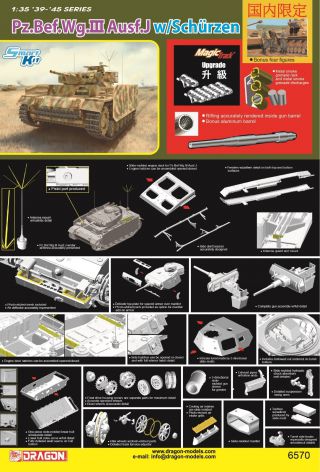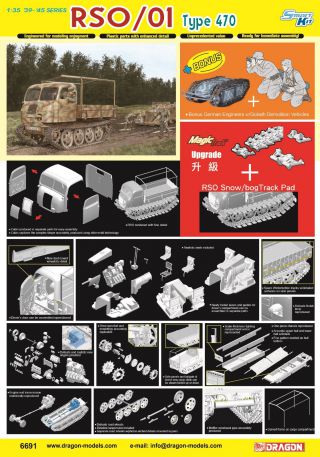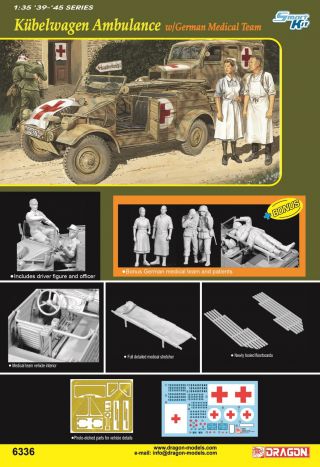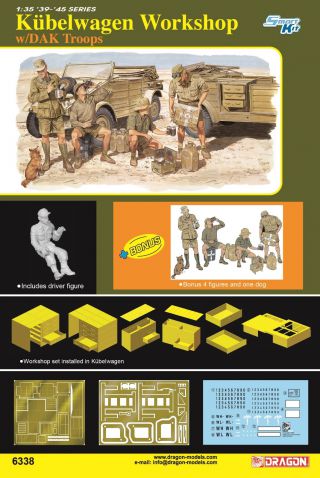HOME → Dragon Plastic Model Kits → 1/35 WWII Military → 6627








Barcode: 0 89195 86627 1
Case Pack: 20 Pieces per case
Box Size: 9.6" x 15" x 3.1"
Features:
- Newly tooled M7 Priest Early Production q/authentic details
- Newly tooled stowage bins for Early Production
- Newly tooled glacis plate finely produced w/weld seams
- Newly tooled fighting-compartment armor w/accurate details on both faces
- Newly tooled one-piece slide-molded transmission cover w/realistic cast detail
- Newly tooled air filters
- Newly tooled vehicle tools have clasp detail
- Newly designed M2 machine gun pulpit provides full field of fire
- Brand new M2 105mm howitzer w/complete breech
- New rear-hull armor plate w/air filters
- Fully detailed brand new T41 DS tracks
- Hatch and periscope cover can be assembled open/closed
- Aluminum gun barrel w/finely reproduced rifling
- Fighting compartment w/accurate interior detail
- Floor pattern realistically produced
- Transmission w/excellent detail
- Anti-aircraft MG w/gun mount
- Detailed ammunition set included as bonus
- Intricately reproduced gun elevation system
- Fully detailed gun cradle mount w/bolt and support-brace details
- Gun breech made by slide mold
- Shield supports connected to gun also included
- Gun mount w/hand wheels finely reproduced
- Engine compartment rear panel is sharply detailed
- Detailed instrument panel
- Includes driver’s controls
- Lower hull made by 2-directional slide molds
- Bolts and rivets delicately represented on hull bottom
- Towing eyes included
- Accurately reproduced suspension
- Suspension bogies w/realistic cast detail
- Idler wheels have delicate detail
At the time of its entry into WWII, the USA relied heavily on the M3 Lee tank. Very early on it was realized there was a need for an armored and fully tracked self-propelled howitzer able to keep pace with armored formations. The resulting design, based on the M3 chassis and featuring an M2 105mm gun, was the 105mm Howitzer Motor Carriage M7. In British service it was, due to the .50-cal machine gun mounted in a prominent pulpit-like structure, called the Priest. Production of the 22.97-tonne vehicle commenced in April 1942, and a total of 2,814 M7s were eventually built. Early M7 Priests served with both the US Army and the British in North Africa and the Mediterranean. Each US armored division featured three battalions of the successful M7.
Dragon’s new 1/35 scale kit of the M7 Priest depicts an Early-Production type. It builds on the popular success of the Mid-Production kit (Item No.6637), and it features correct characteristics such as the howitzer (with an aluminum barrel featuring delicate rifling), ammunition stowage, transmission cover and M3-type bogie suspension. Among the many newly tooled parts are the side-armor plates for the hull, and new stowage bins on the rear of the hull. The interior of the main fighting compartment is particularly well done with full detail such as the 105mm M2 howitzer, stowed and ready-to-use ammunition rounds, intricate driver’s compartment and complete transmission. With the arrival of this kit, those modelers waiting for an Early-Production version of the M7 Priest will now be able to offer up a prayer of thanks!
Reviews:
DR6627: M7 Priest Early Production
1/35 injection plastic kit with decals, metal barrel and photo etch
The early productions M7 Howitzer Motor Carriage (HMC), largely produced before
America entered WWII were widely used by the British Commonwealth in the Mediterranean
Theatre. These AFVs were made in mid to late 1942 and were built on the M3 chassis.
Distinguishing features included side armor without hinged extensions, a shallower
ring for the machine gun 'pulpit' , and an earlier design for the rear stowage.
The British called it the Priest, which reflected that the machine gun ring
resembled a pulpit and the British practice of naming self-propelled guns with
the titles of church officials. The M7 mounted a 105mm howitzer and formed the
backbone of the US armored division's self-propelled artillery. They were well
regarded and many early production models were also used in Europe including
some assigned to the Free French.
OVERVIEW
This 2012 Dragon release depicts an early production version; typical of many made in 1942 and seen in front line photos. It shares many parts with Dragon’s previous release of a mid production model (early 1943 build) and has new parts for side armor, stowage bins, glacis and transmission cover, air filters and a revised lower hull.
Photo etch is provided for four mesh screens while other small detail is captured using modern molding techniques. The barrel tube is turned metal with a hollowed out muzzle. The gatefold instructions have 12 steps of line drawings and the tracks are one piece Dragon styrene.
This kit is in the Smart Kit format and experience with the earlier mid production Priest indicates it will also assemble favorably. Some modelers may want to add extra stowage often in photos both on exterior and interior of the M7, and for guns in British North African service the sand shields.
NEW ARMOR PLATES
This kit has new tooling for the early design of upper side plates. These are large parts with detail on the inner faces and on the exterior separate parts are used to depict the rungs for crew access.
The engine deck has new parts for the early design stowage boxes. The engine deck itself is based on a slide molded cover with separate parts for the fitting such as tools, tow cable (made from twisted metal with plastic eyes), flaps, and the PE mesh screens over the vents (solid casting). The tools have integrated claps.
On the Priest's front there are separate parts for small fittings, like the lamp guards (clear plastic is provided for the lens), spare tracks (one part per rack to save time and avoid misaligned gaps between links) and flaps.
The fighting and driver compartment is impressive, and definitely in the Smart Kit format. Features include a single piece floor tub with anti-skid, detailed bulkhead with sharp integrated detail for several fittings and separate parts for the range/cleaning rods, crew seats, driver’s steering and braking levers. The ammunition bins come partly filled with crisply cast cases. The kit now includes two loose 105mm rounds and two loose ammo stowage tubes..
The pulpit mounted Browning machine gun is mounted on a multi-part U shaped bracket and has a separate ammunition box. The pulpit’s ring and upper curved armor are separate parts. The inner face of the front armor is detailed and includes the dash board with dials. The driver’s compartment also features the transmission and shaft.
HULL & TRACKS
The lower hull has more new and refined parts than first impressions suggest. The revised one-piece lower hull tub has ample detail on the belly plate (and correctly no escape hatch), and very nice riveted angled plates at the join of the hull sides and sponsoons. The rear hull plate includes a pair of new earlier profile air filters. The suspension has VVSS bogies (Vertical Volute Spring Suspension) and the road wheels have five spokes with lightening holes.
This kit has a new three-piece cast cover for the transmission and final drive. It is based on a slide-molded part with separate parts for the ribbed vertical joins and horizontal join to capture the numerous bolts.
The tracks are the T41 pattern which had flat reversible rubber tread. They are the one-piece Dragon Styrene (DS) type which works well for the M3/M4 series tracks..
105mm HOWITZER
The M2A1 105mm howitzer comes complete with crisp hand wheels, sights, cog wheel, spring and slide molded breech. The howitzer’s cradle has sharply defined bolt heads and captures the H profile of the mounting bars. The howitzer has a drop fit metal barrel with a drilled out muzzle with internal rifling. The gun’s traverse and elevation mechanisms are realistic and feature crisp teeth on the arcs. The gun shield has detail on the inner face and includes the lower plates and the metal mounting rods.
DECALS
The kit has one large decal sheet which provides the markings for the six profiled M7 Priests. They cover a range of units, paint schemes and locations which is pleasing.
� One M7 is olive drab with faded US army stars (decals are nicely faded and have black circles and stars and not white as per box art) and ‘Mable’ on the side. It is identified as ETO 1943 (in 1943 USA group troops on the continent were in Italy in the MTO (Mediterranean Theatre of Operations).
� The second olive drab M7 has solid white stars and registration number 3934680S. It is identified as being in the USA in 1942.
� The third live drab M7 has solid white stars in circles and is from the Anzio fighting in Italy 1943.
� The next two are from Commonwealth units in Egypt 1942 with their distinctive sand based camouflage scheme and markings such as a red triangle (some references differ on color) and the bull unit emblem. They are guns H and E from A Squadron, 11th Regiment, Royal Horse Artillery, 1st Armoured Division.
� The last is from the Free French in France 1944 and is from their 2nd Division Blindee.. It is olive drab and has Free French emblems (Cross of St Lorraine on shield), blue square with 'IA' text, and the white marking 'Franche-Comte'. Photos of this gun show plenty of external stowage.
RECOMMENDATION
Dragon's early production M7 Priest will build into an attractive model with crisp tooling. This kit will be rewarding to assemble out of the box and offers the potential for both super detailing and adding stowage to give a more front line feel. With its widespread use by both US and Commonwealth forces I am sure many people will be please with this well recommended release.
- Neville Lord
Kit Review: Dragon Models Limited 1/35 Scale ‘39-‘45 Series Kit No. 6627; M7
Priest Early Production - Smart Kit; 302 parts (287 in grey styrene, 10 clear
styrene, 4 etched brass, 1 turned aluminum barrel); pre-order price US$57.95
via Dragon USA Online
Advantages: very nicely done changes to earlier kit to produce the early production
variant; excellent 105mm howitzer
Disadvantages: Few noted other than selection of T41 track may limit options
(see text); fixed ammunition stowage limits options
Rating: Highly Recommended
Recommendation: to all “redlegs” and US armor fans, as well as Allied forces
and postwar
As I stated with my first Priest review, during WWII there were four iconic
open-topped self-propelled guns used by the major powers: the German 15 cm “Hummel,”
the Canadian-designed “Sexton” with a 25-lb gun, the Soviet SU-76M, and the
American M7 150mm HMC “Priest.” The latter three were excellent designs and
went on to live long after the war, all three serving into the early 1960s with
various second- and third-world armies. Two of them, the Sexton and the M7,
were based on the reliable US M3 medium tank chassis.
The M7 came about due to a perceived need for self-propelled armored artillery
weapons to keep up with armored divisions. After a number of prototypes were
tested, the M7 entered service and full-scale production in April 1942. While
it was based on the M3 chassis, it also absorbed many of the changes that came
about due to the introduction of the M4 series medium tanks and reflected those
changes as production proceeded along. A total of 2,814 were built as well as
826 of the later M7B1, which used the M4A3 tank’s Ford GAA engine in place of
the original’s radial air-cooled engine. Roughly one-quarter of these vehicles
served with the Allied forces, going to the British and Canadians (and later
replaced by the Sexton, which carried the preferred 25-lb gun in place of the
American M2 105mm howitzer) and the Free French forces as well as postwar MAP
deliveries to many other countries.
DML has now followed its earlier mid-production M7 Priest with suitable changes
to realize the early production models – new sides and new tracks accompanied
by other “tweaks” to the molds and sprues.
This kit closely replicates the early version and has done a good job, with
the new sides less folding panels capturing the sculpted sides very nicely.
It also includes the early model stowage bins for the hull rear. The riser for
the “pulpit” is also absent. The model retains the early model bogies with five
spoked welded wheels and six-spoke idlers, machined drivers, but now substitutes
the early T41 irreversible rubber block tracks. The additional air vents are
present on the engine deck as are the covers that go over the top of those vents.
Grouser bins with grousers molded in place are provided as is an interior of
all visible components. The kit also comes with the current generation of DML’s
take on the M2HB machine gun. Top bows are provided but only in their stowed
positions.
As some sprues were used intact from the first kit, note that DML did skimp
on some items. For example, the ammo racks come filled less four rounds on the
right and six on the left; while more to scale than the Academy ones and with
at least the dividers in place, but this time they have added two cased and
two uncased rounds. All of the engine deck vents are solid with the brass grille
work simply mounting over them, but as little can be seen through the original
even from a few feet away this may not be bad other than making their installation
more difficult to accomplish in a clean manner. The engine access doors are
molded closed and the auxiliary air vents are also solid. However, it does come
with the earlier “round” air cleaners.
The T41tracks are a good set and represent their prototype well, but the T41
tracks were short lived and a set of T51 tracks may have been more appropriate.
The lower hull is a new mold for this kit and includes the mounts and baffles
found in the Priest. The transmission cover replicates the same version as the
Academy kit but is cleaner and has a more realistic cast texture. The driver’s
instrument panel is the long narrow type. The interior is fairly complete as
the upper hull is molded in flat components and as such has inner and outer
details on the fighting compartment section.
Stowage bins are the non-vented top-opening type , but while these now come
with the top fittings nothing is provided to store in them.
The M2A1 howitzer is provided verbatim to include the turned aluminum forward
section and in this case is missing the shield Steve Zaloga noted was a later
addition. A complete new lower carriage and the original travel lock for the
weapon (which interfered with access to internal hull ammo stowage) is also
provided. Three grouser bins are provided but the grousers are molded in place.
Technical support for this kit is listed as the H3 Design Office.
Six finishing options are offered: Unidentified Unit, ETO 1943 (OD, “Mabel”
with painted out stars); Unidentified Unit, USA 1942 (OD, white starts, registration
number 3934680S); Unidentified Unit, Anzio 1943 (OD, white stars with circles);
A Squadron, 11th Regiment, Royal Horse Artillery, 1st Armoured Division, Egypt
1942 (sand, brown and green, red triangle H); A Squadron, 11th Regiment, Royal
Horse Artillery, 1st Armoured Division, Egypt 1942 (sand, brown and green, red
triangle E, census number 169299); 2nd Division Blindee, Free French Army, France
1944 (OD, 1A - “Franche-Comte”). A sheet of Cartograf decals is provided for
all options.
Overall, this kit offers the early model Priest and is nicely done.
- Cookie Sewell
M7 Priest - Early Production
Manufacturer: Dragon models
Scale: 1/35
Material: Styrene, aluminium, photo-etch & vinyl
Serial Number: 6627
Price: TBA
Introduction
In July of 2010 Rob Matthews did a review of the Dragon M7 Priest Mid-Production
kit that had just been released.
Rob Matthews:
The M7 105mm self propelled gun was developed to provide Armoured divisions
with mobile artillery. Introduced in 1942, approximately three and a half thousand
units were produced which were used extensively throughout all theatres of WWII
and beyond including Korea. It was based on the M3 vehicle, mounting the 105mm
Howitzer M2 which itself became the most produced artillery piece in the U S
WWII arsenal. The distinctive machine gun pulpit ring offset to the right of
the vehicle lead to it being christened 'Priest' by its crews and this name
has remained.
Both Italeri and Academy have previously provided versions which have met with
mixed reactions from modellers. Dragon now provide us with a Mid-Production
vehicle which hopefully will rectify many of the inaccuracies present in previous
models and provide modellers with a state of the art version of this popular
allied vehicle.
Since this kit is very similar to that one, and I know next to nothing about
the Priest, I will refer readers to his review of that kit and merely point
out any differences in what is supplied in the box. I'm sure members will fill
in any gaps on the forum!
Contents
REVIEW: Dragon M7 Priest Mid-Production #6637 by Rob Matthews
There are very, very few differences in terms of kit content between this release
and the earlier release of an early production model referred to above. The
sprues supplied are mostly identical, the only differences being what is marked
as 'not for use', and a few other smaller differences I'll list in a moment.
Of course, the marking scheme on the instructions, in terms of included decals
are different too, but there is essentially very few new parts on offer.
The largest sprue in the box in the earlier mid-production release was sprue
A, that consisted of various parts to make the superstructure of the vehicle.
In this release, the two irregular panels that form the side walls of the superstructure
are omitted and instead supplied on a new sprue, together with two new stowage/tool
boxes for the rear of the vehicle. Whilst these two new superstructure side
walls remain almost the same in profile, they now have all their tie-downs on
their outer surface removed, along with the 'pulpit' circular protuberance on
the right wall, which exists only as a circular disc now on the top edge of
the wall. A small number of on-vehicle tools are now marked as 'not for use'
on other sprues, and a small transparent sprue from one of the Dragon US Halftrack
kits has been included just for the two headlights lenses. The armoured panels
that extended the height of the walls of the fighting compartment in the earlier
release are still supplied on sprue D but again, are marked as 'not for use',
as are the two tool/stowage boxes on that sprue and the two grab rails for the
outside wall of the fighting compartment. There is also a tiny new sprue attached
to one of the larger ones that has two fibreboard ammunition cases and two shells.
Since the two ammunition bins are moulded with some empty spaces, I presumed
initially that these could be fitted into the empty spaces at random to offer
a slightly different appearance. However, they don't fit, being too large a
diameter, and are differently detailed too in that the yellow band near the
top of the fibreboard cases is actually a moulded into the two new cases, and
although the instructions indicate that the decal number '6' should be applied
to represent the yellow stripe on the ones in the bin, that decal sheet has
been omitted from this release along with the numbers decal sheet.
That's it. Everything else is the same. Well...almost. In the mid-production
model we were supplied with the T48 Rubber chevron tracks in Dragon DS100 tan-coloured
vinyl, whereas in this release we're instead supplied with the T-51 rubber block
tracks in the same material.
Markings-wise, there are six options on offer, which are detailed below. If
you take a look at the scan of the decal sheet you'll see something a little
unusual though. One of the schemes on offer has the white Allied star in a circle
thoroughly worn, almost scrubbed out in fact. Dragon have very nicely made it
so that this effect can be achieved with ease by first using a 'normal' white
decal, and then affixing another olive drab coloured decal over this to achieve
the scrubbed look. Although I haven't tried it yet, I can't see any reason why
it shouldn't look very effective!
Another superb release from Dragon, superbly engineered, superbly moulded, and
no doubt a pleasure to build.
- Vinnie Branigan
Kit, DML 6627, M7 Priest Early Production
Product Specifications.
6627, M7 Priest Early Production Smart Kit. 1/35th-scale injection-molded styrene/multimedia kit. Contains: 295 styrene parts (including eight clear), two DS100 flexible styrene track lengths, one etched brass fret, one length of braided metal wire, one turned aluminum gun tube, six decal markings schemes and six pages of instructions in 12 steps.
Introduction.
DML has slightly back-dated their original M7 to an early production version by the usual method of swapping-out a sprue, adding some new parts and adding new markings. In this case, the superstructure side and rear plates have been replaced with the type that did not have the fold-down armor panels; the MG pulpit does not extend below the upper rim of the armor. In addition, new, side-opening stowage bins are added to the engine deck; these also feature fittings molded in place to accommodate auxiliary fuel tanks. Finally, DML has added two separate 105mm rounds as well as two separate ammunition stowage tubes.
While it is nice to see this variation, DML has chosen not to address some concerns I had expressed in my original report on kit 6637. Indeed, the markings included bring up even more issues. See my comments, below.
Readers should note the following: I am using, wherever possible, US ordnance parts numbers to help describe some of the components in this kit. These numbers are found in several of Steve Zalogas books and magazine articles, where he acknowledges Joe De Marco and Richard Hunnicutt as his prime sources regarding M4 esoterica. Any lapses in the interpretation of these numbers are my responsibility.
Tracks.
These are composed of two lengths DS100 material, molded in soft styrene, which can be fixed together using standard styrene cement. They represent rubber block types and the detail is typical of tracks molded in this fashion: crisp and accurate. Of note, these tracks also have excellent detail on their sides, with the end connectors and track pins sharply portrayed; this makes them a rival to any individual link tracks on the market in the detail department. And, they are far more quickly assembled. The modeler is advised to ensure that the idler wheel axle (a separate part, which will need to be slightly modified) is doing its job, so the tracks are properly tensioned.
Suspension System.
This is the early D37893 VVSS suspension system, commonly referred to as the M3 type, which was first introduced in DMLs M4A1 DV kits. The read-wheels are the welded D38501 types with five spokes, which feature properly-placed grease nipples and relief valves. The brackets consist of inner and outer halves and there are separate two-part volute springs that go between them, return rollers and two swing arms; after assembly the latter will remain movable. The main parts have fine casting texture, but there are no foundry symbols or numbers present. The parts go together well, but I needed to apply pressure and some super glue when assembling the inner and outer halves of the brackets. Only one pair of drive sprockets, of the open type, is provided. The idler wheels are the welded type with six spokes. The final components for the suspension are the axle spindles for the idler wheels and a mounting plate. It is recommended that the idler wheel axles are not fixed in place until the tracks are fitted. Unlike previous DML M4-based kits, these can not be adjusted to help properly tension the tracks. With a simple modification, they can be made adjustable, which I recommend, so that the tracks can be properly fitted.
Hull.
The lower hull is provided as a single, slide-molded part and depicts the riveted type. It is not the same part included in earlier M4-based releases (or the most recent iterations, for that matter), since upon close examination, there are some subtle detail differences; also, an entirely new row of rivets and a flange has been added beneath the molded-on sponson floors. It features proper rivet, bolt, panel and rib details, while the escape hatch lid on the belly has been properly deleted. The hull sides also have the mounting plates for the VVSS brackets molded in place. Internally, there are mounting locations for the M7s main floor plate, as well as some molded-on dividers. All that is missing is the row of bolts on the side walls, directly aft of the transmission/final drive housing.
Up front, there is a 12-part, E6480 three-piece cast transmission/final drive cover. Unlike previous DML kit releases (except for their first M7), this one has a separate mounting strip with bolts. This is because the upper rim has a deflector lip, not seen on the parts in the M4A1 DV kits. This assembly has subtle casting texture, foundry numbers and drain plug details. The bolted-together flanges used to assemble the cover come as one part per side; in reality, this is a two-part assembly, so the modeler should be careful during clean up, RETAINING the seam for the proper appearance. The final items are separate tow shackles and their mounts.
The hulls rear plate features molded-on engine compartment access door lids, to include a molded-on grab handle. The plate transitions to the hulls belly plate at an angle, rather than as a curve. Other items such as the usual tow shackles and their mounts are given, as well as a two-part trailer hitch. The multi-part carburetor air cleaners represent one variation of the round type. The final items are the exhaust pipes with their fish-tail ends, which is presented as a three-part assembly.
Superstructure.
The basic shape of the superstructure is captured quite well, with subtle weld bead detail and tie-down loops present where appropriate. The side plates are quite thinly-molded and there are no unsightly and difficult to remove knock-out pin marks present anywhere. The side and rear panels around the fighting compartment are now devoid of the hinges needed for the later folding extensions that covered the ammunition stowage bins. However, the extensions are still in the box. Each side plate also mounts two pairs of separate ladder rungs for crew access; that on the starboard side represents the type with the shallower, original MG tub.
The superstructure front plate properly captures the appearance of the curved top section. Separate head-lamp mounts and horn are provided, as are the relatively thin and appropriately-shaped brush guards. The head-lamps are provided with clear lenses. The drivers view-port flap is separate. Unfortunately, the prominent mount that held the stem, which in turn secured the flap in the open position, is molded in place. It is therefore, poorly represented, while the stem itself is molded in its stowed position on the inside face of the view-port flap. All of this means that opening the view-port flap will require extra work from the modeler.
Three grouser boxes (representing one known variation) are provided and they are fully stowed with grousers; personally I would have preferred that they were empty with separate grousers. This would allow the modeler more display options since these boxes were frequently used to stow all manner of things. The spot welds that held them in place are also present on the superstructure part, which is a nice touch. The final items are a filler cap for the area above where the transmission is mounted, as well as separate fenders for each side of the superstructure.
The rear of the superstructure consists of an extension plate on each side and another plate bridging the two, across the rear. The extensions each have a separate tail-lamp and include fine weld detail. The bridge plate features an opening for the engine starter crank and a separate axe for stowage. The final items in this location are the two mud flaps, one on each side above the idler wheels.
No sand-shields or mounting attachment points are provided.
The engine deck part is separate and features crisp bolt and panel details. Three etched brass parts for the screened areas are provided and they fit into recesses on the deck. The forward-most grill covers the engine deck air cooling intake vent. However, it and the two smaller vents are not opened up, but merely very slightly recessed. The small screens are covered with plates that extend somewhat above the surface, so the fact that they are not open beneath is difficult to see. Not so for the larger air cooling vent, where parts of the engine can easily be seen if it were open. So, the modeler can either accept DMLs design decision or open things up. If doing the latter, some detail must be added inside.
The tool stowage is well done and these items are all separate parts. There are attempts on some of the tools to depict the straps that held them in place. Some have this treatment and some do not; some only have part of the strap molded in place. I applaud the idea and think that the execution simply needs to be tweaked. Braided metal wire and styrene end loops are given to create a tow cable. The end loops have strap details molded in place as well, but their overall appearance seems to be somewhat undersized. The two stowage boxes appear to be properly-sized and represent the earlier side-opening type with mounting brackets for auxiliary fuel tanks on top. Other items on the deck include several fittings whose purpose is unknown to me, as well as separate fuel filler port caps. While previous DML M4 kits often had detailed openings under the caps, this kit does not.
Fighting Compartment.
The prominent ammunition racks are partly filled with closed packing tubes; there are several empty cells in each for a more candid appearance. Overall molding is quite fine, with all of the cell walls crisply represented. Two each of extra packing tubes and 105mm rounds are now provided. There are a few small brackets present, some of which are separate and some of which are molded in place. The rear bulkhead has various fittings molded in place, plus several separate stowage items, which I assume are aiming stakes and/or gun tube bore swab staffs. The plate is partially covered by a sheet metal shroud, which features an etched brass part for the screened opening. The opening itself is not actually open, which seems to be an odd engineering decision. I recommend that it be carefully opened, leaving the molded-on rim in place to fit the screen. The floor plate is a separate molding featuring scribed lines representing the ammo bins and other openings, as well as proper tread plate pattern.
The drivers instrument panel well-represents the type compatible with the Wright radial engine. There is a separate floor panel for the driver (with molded on foot pedals), to which a rather simplified two-part seat is added. The drivers prominent hand controls are given as separate parts, which link with the transmission. The transmission itself is made up of multiple parts, but details are missing. Above the driver is situated a stowage box for the gunners sight quadrant. On the opposite side, below the MG pulpit, are parts to represent a tool drawer and part of the .50 cal ammo stowage tray. No ammo boxes are provided for this area nor are parts for the racks that stowed the crews personal weapons, or the weapons themselves. A pair of two-part folding seats is given, one for each side of the fighting compartment, as are a pair of fire extinguishers complete with mounting brackets.
The .50 cal. M2 heavy machine-gun is a two-part affair with separate grips; it comes from a slide-mold so is pre-bored. The cradle is molded with the gun, while the pintle is separate. A separate ammo box, a three-part skate rail mount and a separate gun barrel travel lock complete the area. The ring mount is very well-detailed, capturing the look of the original quite nicely; the prominent brace for the mount is also given. Overall, the M2 looks OK, but the cocking handle needs replacing as it is too small.
Howitzer.
The howitzer is mounted on an adaptor base, which in turn fits onto a receptor on the floor plate molding. Separate I-beams are provided to extend from the mount to the lower hull side walls.
The core of the howitzers tube is slide-molded, and has the recuperator cylinder, recoil cylinder and the main portion of the tube molded as one piece. The tube is completed with a turned aluminum and styrene bore end, a recuperator cylinder cap, a two-part breech ring, and a two-position, two-part breech block. The aluminum bore end has rifling on its inner surface. The two parts representing the recoil sleigh are then added.
The cradle assembly is a five-part affair with a separate front end cap. The latter part is the type seen on the towed howitzer and sometimes on the M7. Most photos of the M7 show an armored cap which is bolted in place; this is not in the kit, but can easily be added using styrene sheet. The equilibrator spring assembly is based on a slide-molded core. It is complimented by a movable bearing spring rod, which ties in to the carriage assembly.
The cradle assembly is then mounted to the carriage and elevation mechanism, which has the proper lighting holes and gear-tooth detail on its quadrants. This item will traverse and also elevate, so be careful with the glue when you assemble it. Separate linkages for both elevation hand-wheels and the single worm-and-rack traverse hand-wheel are given as are the hand-wheels themselves. The M21A1 telescope mount, M12A2 panoramic telescope, M4A1 range quadrant and M23 telescope mount parts are all included, and they compare quite well to TM photos. Note that the M12A2 panoramic telescope should be carefully cut off and returned to its location at an angle, per photos. Many small non-descript parts provide for the final details.
Molding, Fit and Engineering.
Molding is excellent, with fine seam lines and no ejector pins visible after assembly. Fit should be generally OK, based on my experience with kit 6637. I originally noted some places where things went slightly amiss. The recoil slide has a prominent seam when assembled, so filler and some careful work will be needed in its elimination. The ammo bins will need a slight amount of thinning on the walls that butt up against the superstructure side plates. The breech will also need care in its clean-up. Otherwise, I found fit overall to be excellent.
Instructions.
These are typical for DML and are well drawn. They are relatively brief, since the parts count in this kit is not excessive. There are some glitches: parts B37 and B38 are reversed in the drawings. Part blue A40 is shown being assembled, but has no corresponding part number shown on the instruction sheet. Painting instructions are rather sparse as they dont give information for the colors of the .50 cal. M2, the instrument panel, the ammo stowage tubes, the newly-included 105mm rounds, seat pads and other small details. It should also be noted that the instructions show the application of the yellow stripes to the ammunition stowage tubes, but the decals were not included in my sample.
Accuracy and Details.
There are a small number of omission and detail issues as follows:
Tow cable end-loops are provided, but they appear to be undersized.
According to Hunnicutt, vehicle specs call for: Provision for (3) .45 cal. SMG
M3; according to TM 9-731E C1, its one M3 and six M1 Carbines. These two denominations
probably represent the evolution of the amount and type of small arms stowed
in specific versions of the M7. Regardless, no small arms or their stowage racks
are provided by DML.
The very visible mount for the stem that holds open the drivers view-port is
overly simplified. It and the stem should have been separate parts.
I dont understand the wisdom of providing etched brass screens for certain areas,
while leaving the openings beneath them sealed.
The firing lanyard for the howitzer (part blue A16) is only partially represented;
it lacks the pull-cord with its wooden handle.
The tray that held the extra .50 cal. ammo boxes, just forward of the pulpit
is only partially represented; there are no extra ammo boxes in the kit.
No sand shields or their mounting points are provided.
Decals and Markings Information.
The water-slide decals are printed in Italy by Cartograf. They are this companys usual fine product and have crisp edges, well-saturated colors and perfect registration. The designs are individually covered with a thin, clear, matte film, cut close to their edges. Markings and painting information is provided for a total of six M7s, as follows:
Unidentified US Army unit, ETO 1943.
Unidentified US Army unit, USA 1942.
Unidentified US Army unit, Anzio 1943.
Gun H, A Battery, 11th Regiment, Royal Horse Artillery, UK 1st Armoured Division,
Egypt 1942.
Gun E, A Battery, 11th Regiment, Royal Horse Artillery, UK 1st Armoured Division,
Egypt 1942.
Franche Compte, French 2nd Armored Division, France 1944.
The first thing I noted relating to the decals is the lack of the inclusion of the yellow stripe decals that are used on the ammunition tubes. These were included in DMLs first M7 kit and are shown in step 8 of the instructions for this release.
References confirm the general appearance of the one French and two British schemes, although the British ones appear to have some issues. For instance, references indicate that the Battery Signs should be blue and not red as the kit supplies. Furthermore, gun H should have a census number, 5160306, on the rear of the superstructure side plates. Both had sand shields fitted and these are not in the box. Finally, the color descriptions are suspect as are the patterns. Simply stated, if replicating a British M7, the modeler must consult his references!
Conclusion.
Overall, this kit is visually quite accurate, although it falls somewhat short when it comes to some of the smaller details. There are some rather annoying omissions, foremost of which is the lack of sand-shields, particularly since two of the included markings schemes demand them. There are issues with the colors to be used as well. So, in short, it is a fine basic kit, but some extra work will be required to bring it up to a more acceptable standard.
- Frank V. De Sisto

